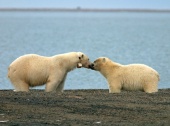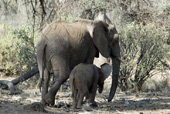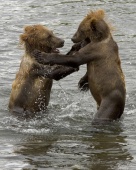Species on the brink of extinction affect us all more than we may realize. Sure, the pandas are cute, and the rhinos are fun to look at, but is there any more to it than that? Absolutely.
All animal and plant life is part of a complex ecosystem that also includes our lands and our waters. Remove one or more of those parts and you damage the ecosystems, sometimes beyond restoration. These ecosystems provide clean water, breathable air, fertile soils, climate control, food, medicine, energy, building materials, transportation, as well as recreational and spiritual uses. Many groups are working to protect endangered species and their habitats; they are mentioned throughout this post and at the end.
According to the US Fish and Wildlife Service:
415 species are endangered in the US
164 species are threatened in the US
541 species are endangered in other countries
50 species are threatened in other countries
In 1973, Congress passed the Endangered Species Act (ESA). Why should we save endangered species? The introduction recognizes that endangered and threatened wildlife and plants “are of esthetic, ecological, educational, historical, recreational, and scientific value to the Nation and its people.” The purpose of the ESA is to “protect and recover imperiled species and the ecosystems upon which they depend.” It is administered by the U.S. Fish and Wildlife Service and the Commerce Department’s National Marine Fisheries Service (NMFS).
According to the World Wildlife Fund (WWF) , “destructive human activities” have increased the rate of species extinction from 100 to 1000 times the natural rate. WWF lists the following 8 animals as flagship endangered species. Flagship species are used as icons to denote the broader problem. (All info on the 8 taken from wwf.org.)
Tigers
Tigers are one of the most threatened species in the world, with only about 3200 Tigers left in the wild. The biggest threats to these animals are growing human populations, habitat loss, illegal hunting, trade of tiger parts used in medicines.
Pandas
 Although pandas are one of the most popular and famous animals on earth, there are only about 2500 pandas left in the wild. The biggest threats they face are habitat fragmentation and unsustainable development.
Although pandas are one of the most popular and famous animals on earth, there are only about 2500 pandas left in the wild. The biggest threats they face are habitat fragmentation and unsustainable development.
Sumatran Rhinoceroses
 This smallest of the living rhinoceroses is critically endangered, with only 300 alive in the wilds. The biggest threats to these animals are habitat loss and poaching. The forests in which they live need to be saved.
This smallest of the living rhinoceroses is critically endangered, with only 300 alive in the wilds. The biggest threats to these animals are habitat loss and poaching. The forests in which they live need to be saved.
Polar Bears
 Not endangered as yet, polar bears number between 20,000 to 25,000, perhaps due to the 1973 International Agreement on the Conservation of Polar Bears and their Habitat. However, culture change and warming trends pose a very real threat to polar bears over the next century.
Not endangered as yet, polar bears number between 20,000 to 25,000, perhaps due to the 1973 International Agreement on the Conservation of Polar Bears and their Habitat. However, culture change and warming trends pose a very real threat to polar bears over the next century.
Whales
 Seven of thirteen whale species are endangered or vulnerable. The greatest threats include oil and gas development in feeding grounds, collisions with ships, entanglement in fishing lines, commercial killing, toxic contamination, climate change and habitat vulnerability.
Seven of thirteen whale species are endangered or vulnerable. The greatest threats include oil and gas development in feeding grounds, collisions with ships, entanglement in fishing lines, commercial killing, toxic contamination, climate change and habitat vulnerability.
Pygmy Elephants
 Smaller than other Asian elephants, pygmy elephants number only about 1600 in the wild. Biggest threats to these elephants are habitat loss and human conflict.
Smaller than other Asian elephants, pygmy elephants number only about 1600 in the wild. Biggest threats to these elephants are habitat loss and human conflict.
Marine Turtles
 Many marine turtles are endangered and critically close to extinction.
Many marine turtles are endangered and critically close to extinction.
“Having traveled the seas for over 100 million years, sea turtles have outlived almost all of the prehistoric animals with which they once shared the planet. Having survived the extinction of the dinosaurs, marine turtles still inhabit the oceans’ open waters and coastal habitats, feeding on jellyfish and other aquatic plants and animals.”**
Marine turtles can reproduce abundantly, but even under “natural” conditions, few young turtles survive, and it can take decades for turtles to reach maturity. Biggest threats include habitat destruction, egg collection, hunting, entanglement in fishing lines, and climate change.
Great Apes
 This group includes gorillas, orangutans, and chimpanzees, and are all endangered, some critically so. They are also our closest wild relatives. Serious threats to the great apes include disease, hunting, trade, habitat loss and climate change.
This group includes gorillas, orangutans, and chimpanzees, and are all endangered, some critically so. They are also our closest wild relatives. Serious threats to the great apes include disease, hunting, trade, habitat loss and climate change.
What You Can Do
National Wildlife Refuge System You Can Help 
Endangered Species Program How You Can Help
*I am a big fan of the World Wildlife Fund, so I’ve included links to their “adopt an endangered species” program, simply because I think it’s a cool and fun idea.
** From wwf.org.
Note: Pictures do not accurately represent species listed. They’re just cute pictures. And, yes, I went a little nuts with the bears. (www.classroomclipart.com)





i’ll definitely do something to save endangered species.’Save animals ,Be compassionate citizens’.
LikeLike
It’s a pity you don’t have a donate button! I’d most certainly donate to this excellent blog! I guess for now i’ll settle for book-marking and adding your RSS feed to my Google account.
I look forward to brand new updates and will talk about this blog with my Facebook group.
Talk soon!
LikeLike
[…] I could probably go on, but let me sum this up. If we “fix” something according to what certain groups of people see as the solution, we’re bound to create another problem that needs to be fixed. I found this statement that seems to put things in perspective (https://themessagepub.wordpress.com/2011/02/17/endangered-species-affect-our-ecosystems/) […]
LikeLike
Good article. I certainly love this site. Stick with it!
LikeLike
[…] https://themessagepub.wordpress.com/2011/02/17/endangered-species-affect-our-ecosystems/ […]
LikeLike
Hey, thanks for the blog article.Really looking forward to read more. Much obliged. cdfgbkebgdaf
LikeLike
Superb site you have here but I was curious if you knew of any forums
that cover the same topics talked about in this article?
I’d really love to be a psrt of community where I can get responses
from other knowledgeable individuals that share the same interest.
If you have any suggestions, please leet me know. Cheers!
LikeLike
[…] Endangered Species Affect Our Ecosystems […]
LikeLike
Very good article, I am going to reblog this one for you.
LikeLike
Excellent! Thanks.
LikeLike
You are so right! I hope they are teaching this in schools. It is critical to our survival and people need to be made aware of the urgency. Many people I talk to don’t take it seriously. They don’t see an immediate threat to themselves so they see no reason to act or even educate themselves and their children. Heaven help us!
LikeLiked by 1 person